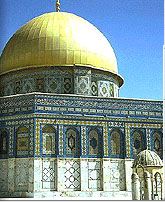|

Al-Aqsa during the Umayyad period
|
Following the construction of the Dome of the Rock, a stone Mosque was erected adjacent to the southern wall of the Temple Mount enclosure by the caliph 'Abd Al-Malik or by his son Al-WalidI (709-715). It is known only from a historical text: a Greek papyrus found in Aphroditoi in Egypt (701-716). It includes a request to send skilled laborers and building materials from Egypt to Jerusalem for the construction of a Mosque. |
|
The Umayyad Al-Aqsa Mosque was constructed above ancient subterranean spaces that had been built by King Herod (37-4 BCE) when expanding the area of the Temple Mount. This is probably why the Mosque had been destroyed so often by earthquakes. The principle remains of the Umayyad period Mosque are its southern wall, a number of square pilasters east of the mihrab, a fragment of a polychrome mosaic nearby and splendid carved wooden panels discovered at the time of the Mosque's restoration in the 1930s. Limestone and gray marble flagstone remains are witness of the Mosque's fine floors. The Mosque was completely destroyed by an earthquake in 748 CE. |

|


